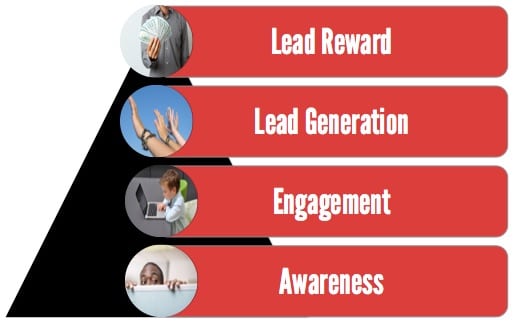Small business content marketing sounds impressive, but to most people the term doesn’t mean anything. Content is vague. Marketing is ambiguous if it’s not immediately confused with advertising. So how do you define content for your small business and how do you prioritize each type?
The first step to understand small business content marketing is to know what we mean my content. Content can be:
- Social media posts
- Social media images
- Videos (for social media or your website)
- Blog posts
- Presentation slides
- White papers/reports
- Webinars
- Live video
- Podcasts/audio
- Interactive games/activities
Essentially anything you present to your audience is content. But that doesn’t help us prioritize what to create and when.
Tier Your Small Business Content Marketing
The best way to prioritize your small business content marketing is to think of it in terms of tiers.

Content Marketing Tier I is the most important, lead-reward, valuable content. These are the payoff pieces of content you deliver to your audience after they’ve given you their contact information. These typically come in the form of online courses, white papers or reports, presentation slides or videos or webinars/online event access. This is where you raise the bar for your content marketing.
Content Marketing Tier II is Lead Generation content. This is the teaser content that persuades your audience to come surrender their email address or other contact information in order to get that Tier I content. This is typically a snippet or teaser portion of the payoff content from Tier I or straight promotional content to illustrate why your audience would want the Tier I content. It can also be an email newsletter or promotion, a blog post or even a video or podcast recording that focuses on why you should take that next step and download the Tier I content.
The third Content Marketing Tier is content that engages your audience. This typically manifests itself as blog posts, videos, podcasts, images or other content that is designed to engage and audience with questions, shares or similar, but doesn’t necessarily lead to a lead generation capture payoff. Sure, a blog post can exist on your site along side a lead capture form, but the point is just to engage the audience. Any lead generation that happens is incidental.
Content Marketing Tier IV is all about awareness. This is everything from what you tweet to your responses to customers on review sites or social channels. It can be prepared just like a blog post, but it’s more short form content making sure you’ve got something to say to your social audiences, keeping you top of mind for their day-to-day experience.
Prioritizing Your Small Business Content Marketing Tiers
So which is more important? Unfortunately, if you’re going to have Tier I, you have to have the other tiers. But do you prioritize the big stuff or the day-to-day you need right now? The answer is going to be different for everyone, but I recommend starting with Tier IV and working your way up. Why?
The awareness play gets people paying attention to you. The engagement phase moves them to a more committed point in your relationship. Now they’re reading more, watching your videos and the like. Now that you have them interested in what you’re providing, you can prepare some Tier II content to entice them to provide you with their contact information. Once that do that, you need that high-value, Tier I content to deliver as a payoff.
But you will need to carve out appropriate time or resources to create that Tier I content. A white paper or report that provides deep information or engagement takes far longer to prepare than a blog post or a social post. So make sure you’re working on that deeper content concurrently while preparing the other tiers and you’ll find yourself less pressed to finish the big stuff on an unreasonable timeline.
An Example
Just to bring a little more clarity to what these tiers might look like, let’s take a company like a home technology installer. Their Tier IV content might be sharing links to reviews of the latest gadgets, speaker systems or even recent Netflix or DVD releases. Tier III content may look like blog posts that offer up home decorating ideas or aspirational slide shows of unique home entertainment or technology installations.
Tier II might be a video that explains why aligning your surround sound speakers in perfect alignment with your seating area is important for ideal sound. The Tier I content then would be a video or perhaps a how-to white paper showing them how to actually realign their speakers and furniture to achieve the best sound experience.
The key to creating awareness, engagement and lead generation for small business is content marketing. But unless you have content marketing tiers it’s harder to prioritize and schedule your content creation to deploy effective strategies.
These are my ideas for prioritizing your small business content marketing tiers. What are yours? And give us examples of your tiered content in the comments to inspire everyone else. The comments, as always, are yours.

